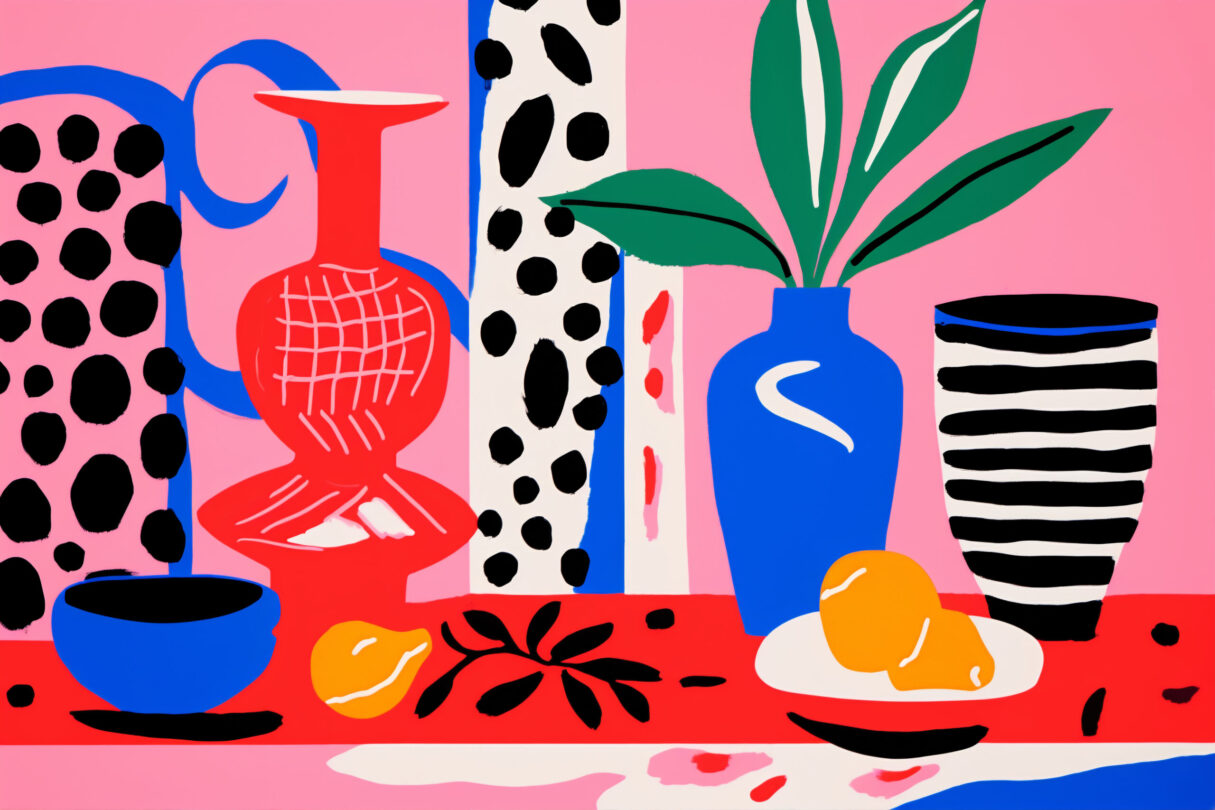A body lies on a black ground, its limply hanging arms glowing white as if illuminated by a blacklight. At the lower edge of the composition they spread out into flat forms and become overlapping planes with oddly proliferative organs. A figure in dark clothing stands behind the laid-out body, holding the glowing hands, examining the mouth and eyes. Janus-faced, one head inspects the patient, while the other one, blindfolded, turns away to the right, where a hand probes its mouth with a curved instrument.
i scatter the white nothing oh, white is nothing. the white smoke’s remorse— pricks the silk of indulgence.1
1. Excerpt from Lou Hoyer’s 2020 libretto Der gerechte Winkel (The Righteous Angle), scene II. Here for the chorus Hoyer has borrowed Unica Zürn’s anagram Ich streue das weisse Nichts, which she has modified slightly. Translated here from German by Caroline Schmidt.
Her drawings and anagram poems, including the above-quoted lines. “Anagrams are words and sentences that are formed by rearranging the letters of a word or sentence,” as Zürn once explained of her art. Lou Hoyer’s black ink drawing is every bit as fragmented, enigmatic, and ambiguous as these lines, which she borrowed from Unica Zürn, in Der gerechte Winkel (The Righteous Angle), her most recent work. Where the story begins and ends remains in the dark, as does who is touching whom, how, and why. Contours become planes that structure the image; positive becomes negative. Bodies flow into fabric; bellies become walls.

sweetness is like whiteness cry out: don’t do it! she’s me, she’s me, she is— i scatter the white nothing oh, white is nothing.2
2. Unica Zürn was born to a well-to-do family in 1916 in Berlin-Grunewald. After finishing school, she worked at Ufa, the German film agency, and wrote short stories for newspapers, until in 1953 she met Hans Bellmer in Paris. The two began a heated romantic relationship, and Bellmer introduced her to the Surrealist circle.
écriture automatique
In her recent work, Hoyer delves into the world of Zürn,3 A strict, yet playful poetic form, anagrams demand utmost focus; Zürn often lost herself for days, wracking her nerves in search of new ways to arrange a set of letters. She also made drawings, for which she adapted the écriture automatique (automatic writing) method practiced by the Surrealists in order to access material directly from the unconscious. Eventually, no longer satisfied by pursuing the two art forms separately, she sought a symbiosis of poetry and drawing, an absolute blurring of boundaries.4
3. Noted from her 1966 memoir Der Mann im Jasmin: Eindrücke einer Geisteskrankheit, in Unica Zürn, Gesamtausgabe: Band 4.1 (Berlin: Brinkmann & Bose, 1991), 148. Available in English as The Man of Jasmine: Impressions from a Mental Illness, in The Man of Jasmine and Other Texts, trans. Malcolm Green (London: Atlas Press, 1994).
4. At age forty-four, Zürn was diagnosed with schizophrenia; for the rest of her life she was in and out of the hospital for treatment. She died in Paris in 1970. Her anagram drawings and texts from those years evidence her hallucinations and visions.
Der gerechte Winkel (The Righteous Angle)

Hoyer, too, fuses various art forms in her own multimedia practice. Her latest series of ink drawings is dedicated to Zürn: dark, sinister, and simultaneously luminous scenes, which depict clinical treatments as well as the latter’s schizophrenic, ambiguous sensory worlds. Hoyer also made Zürn the fictionalized protagonist of her opera Der gerechte Winkel.
She transferred Zürn’s anagram principle to the musical arrangement by assigning a certain tone to each letter. Following a prelude in an airplane, the first scene opens in a clinic, where Unica is put under hypnosis and given treatment, because “the hearts in her eyes are extinguished,” as Dr. Mortimer declares in the libretto:
“the hearts in both her eyes have been hit straight through the breast. completely destroyed, it seems. double bull’s-eye!
When presented with a living will to sign at the hospital, before the hearts of her eyes can be operated on—“so that she will fit back into the world,” as Hoyer writes—Unica says:
until an anagram is “solved”
from now on, i want to be a patient of my anagrams only. i defer to the counted letters. tell it to the doctor. i’m not at his disposal.
Anagrams are her escape into an inner world; the words suck her in, occupy her mind and control her actions for hours, until an anagram is “solved.” In a delirium caused by a fever, before losing consciousness Unica writes the following anagram:
I scatter the white nothing oh, white is nothing. Remorse of the white smoke pricks the silk of indulgence. Sweetness is like whiteness. Cry out: Don’t do it! She’s me! Become sweet night!5
5 Original German published in Unica Zürn, Hexen Texte: Zehn Zeichnungen und zehn Anagramm-Texte (Berlin: Galerie Springer, 1954), unpaginated. Translated here by Caroline Schmidt.
When she wakes up and realizes that the doctors and nurses have mishandled her, she bursts out:
i’ll slay you with a hundred eyelids! i’ll remain forever awake! slay, slay!

The historical person Unica Zürn—the woman plagued by psychiatric treatments and visions—coalesces with the fictional character from Hoyer’s opera to form a polyphonic new narrative, which ties in loosely with Hoyer’s earlier work and takes up the same themes and concerns. For several years now, Hoyer has been combining performance, opera, and drawing. In her words: “I think of myself as a draftswoman who makes performances.”6
6. From a conversation with the author in June 2020.
Opera to Go
In 2018 it was Opera to Go, in which the stage, the painted set, and the artist as performer, her head hidden behind a curtain-veil, merge to form a single entity. That same year, she created a musical spectacle outdoors. Her Symphony for Wind and Waves, performed at the Baltic Sea, tells a story about a woman who believes that by measuring and observing the waves she can learn how they break and thus decode the ocean. With this code she is able to direct the wind and sea and tame nature’s greatest force.
approaching waves, let me create you. let the windy motions of my hands lead you. Let me slow you down, stretch your long, dark spines.
Lou Hoyer
Hoyer’s ultimate symphony is a symbiosis of writing, drawing, and performance. Diary-like notes about the ocean and its gradual subjugation fill the margin of a score; the staves become waves and take over the page, bursting the fixed bars and causing the notes to undulate. It is a jotted-down dialogue between the waves and the wind: both a trial of strength and a lovers’ game at once, full of threat and promise, attraction and escape.
wave: tickle my spinewind: i’ll make you sing, a breathing muscle wave: you dream of me at nightwind: i never sleep, i only breathe
Lou Hoyer
wave: when you lay on my stretching back at night wind: i’ll push youwave: i have been a thousand waveswind: i draw white lines across your ribs
wave: faster, faster wind: unrecognizable.
A Space Of Possibilities
“I would have loved to be a conductor,” Hoyer explained, fascinated. “A director has to imagine the music for each individual voice ahead of time, and then realize it in space. The body is the medium of expression. The conductor brings the individual voices together; they create something new, but only in combination.” Hoyer evokes polyphony in all her work.
She often collaborates with other artists from various disciplines, and her work itself is multimedia. The combination produces something big; the art forms are mutually dependent on and drive one another forward. A drawing becomes an opera, drawn fabric becomes a curtain or a stage, which might depict an actual or imagined space. “A space of possibility,” as Hoyer puts it.
Neither Object Nor Subject

She also opens up this space with a continuously growing work on paper that stretches seventeen meters to date. As in a play, a narrative extends across the length of the frieze, giving it a complex temporality; depending on your perspective, the scenes can be experienced one after another in linear time or taken in simultaneously. A white curtain divides the narrative fragments, serving both to link the individual panels and to highlight the illusionary space of the stage. Fantastic scenes play out before, behind, and below it; there is no beginning and no end, even if viewing habits make us inclined to read the image from left to right.
There, on the left, the white fabric is pierced by sharp thorns; individual body parts and outlines—phallic fingers and vulva-like mouths—emerge beneath it. The fingers seem to be showing the way, bringing to mind art-historical gestures: the finger in the wound, pointing out an important figure, or the much-interpreted fingers from Max Ernst’s painting Au premier mot limpide / Beim ersten klaren Wort (At the First Clear Word),7 which resemble a woman’s crossed legs.
7. Max Ernst, Au premier mot limpide / Beim ersten klaren Wort (At the First Clear Word), 1923, Kunstsammlung Nordrhein-Westfalen, Düsseldorf.
At the same time, the figures to the right of the white cloth, with their superimposed mouths, doubled faces, eyes half-closed as if in a trance, and snail-shaped ears, are reminiscent of Hindu deities, which merge with elements from the pictorial language of the Kama Sutra. Like contemporary cave paintings, symbols from the digital world decorate the gray landscape in the background: a wi-fi signal symbol, loudspeaker icons, an e-mail icon.
the interplay of cultures, mythologies, patterns, and colors
Lou Hoyer’s pictures have their own concept of time, in which everything is possible. She clearly embraces Surrealist motifs, yet not the Surrealist mindset; drawing is her primary concern—chance and the unconscious play a subordinate role here. Nevertheless, her drawings do not deny their hundred-year-old predecessors when animal bodies grow into bridge vaults, bodies coalesce into buildings, or draperies become figures.
But the idea that always flows through them, the occasion for the unfolding scenes, is clear: the contemplation of corporality, the painterly translation of contact, which one can almost trace physically when looking at it. About her work, Hoyer once said,
“My starting point is always the body, being in the world as a body, with skin being the surface that rubs against the world—the sensual.”
Paper, too, is a kind of skin; the surface where her inner world comes into contact with the outer world. And now we’ve come full circle back to Surrealism. Hoyer’s work is also influenced by Renaissance art, including studies made to determine the harmonious proportion of a human figure within a landscape or interior space.
Lou Hoyer says that her paintings and drawings changed after a 2012 residency in Mexico; they became more narrative and vivid, at times more colorful, richer in contrast, more drastic. Beginning in the 1940s, Mexico City was the adopted home of many European artists from the Surrealist circle, who went into exile in Mexico during World War II. There, together with like-minded individuals such as Frida Kahlo, they formed a lively international scene. It is not surprising that Hoyer found inspiration and resonance for her art in the interplay of cultures, mythologies, patterns, and colors that unmistakably defines Mexico’s visual arts and crafts.
erotic scenes through their eyes


Hoyer’s Surrealism focuses on women and the female body, but not as an idealized, sexualized, or trivialized object—as it is depicted in numerous works by Surrealist artists, from Hans Bellmer to Salvador Dalí—but rather as a strong, decisive, self-confident gender in full possession of her beauty and power.
In Hoyer’s paintings and drawings, women live through their bodies, to the fullest extent and with pleasure, without shame or inhibition; they reach out for one another, for breasts and thighs, touch themselves, or grab at the scattered, disembodied male genitals. The women in her work are not object but subject; we view these erotic scenes through their eyes.
Behind the Pretext…
One series of pastel drawings by Lou Hoyer revolves around the Song of Songs from the Old Testament. A collection of love songs told in a very sensual, rapturous, and erotic language, it is unique within the Bible; debate surrounds both its date of origin and authorship. For Hoyer, the Canticles are interesting not only because of their vivid and poetic language, but above all for the roles assigned to the male and female speakers.
Instead of telling a story, the book is a series of alternating praises, a declaration of love between twopeople, a mixture of desire and fulfillment, union and separation. What is remarkable is that the woman speaks far more than the man: erotic lyric from a woman’s mouth—and in the Bible, of all places! Hoyer’s pastel drawings do not illustrate the Song of Songs per se, but instead convey its dynamic and poetry, the fantastic possibilities opened up by its many metaphors, and the sense that human existence finds complete expression only in the presence of a loved one.
glory, incandescence, and love and knowledge
Lou Hoyer’s examination of sexuality is a universal examination of physicality proper. It extends to normative concepts of the body and gender, and interpretive sovereignty over images of naked bodies and beauty ideals, be it in pornography or advertising. In this regard, Hoyer resembles one of the Surrealists who came before her, the artist Dorothea Tanning, who in 1990 said:
“You see, when I paint drifting nudes, it’s a statement about being human. Some people think it’s a statement about being sexy. It’s an obsession of the whole, not so cultural, establishment, that almost everything we do which is inexplicable must be reduced to sexuality, and that’s absurd. . . . after all, there are other yearnings, with names like glory, incandescence, and love and knowledge.”8
8 Dorothea Tanning in an interview with Carlo McCormick, in Bomb 33 (Autumn 1990), 36–41.

For Lou Hoyer, language—spoken or sung, read or performed—is just as essential as the drawn image. She and Unica Zürn certainly would have had a lot to talk about—for example, whether love can be depicted:
I don’t know how to make love
9 Unica Zürn’s anagram poem “Ich weiss nicht, wie man die Liebe macht,” written in 1959 in Ermenonville, France (see note 5). Translated here by Caroline Schmidt.
As I know, you don’t “make” loveIt weeps by a wax lamp in the attic.Oh, it grows in light, in the wind atnight. It wakes in a tender picture, in the ice of never, in the plea: awake, as I do. I know, as I do you don’t make love.9



















You must be logged in to post a comment.